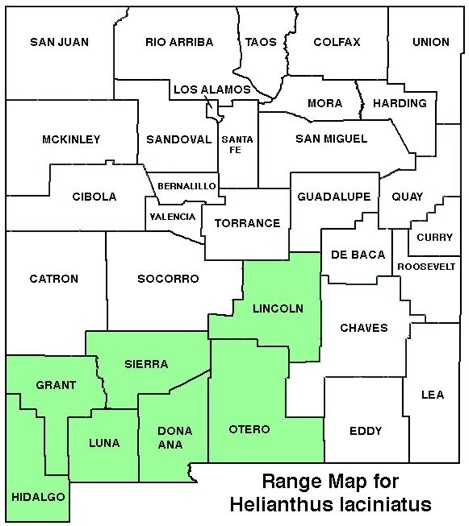WILDFLOWERS OF NEW MEXICO

With hairy stems reaching 1 1/2–4-feet tall and spreading by rhizomes, this plant forms colonies in alkaline flats and drainages in southern NM. Note the roughly hairy, wavy, opposite leaves and reddish-brown disk flowers.
FLOWER: June–October. Flower heads have 14–20 petal-like yellow rays, each 3/8-inch (10 mm) long with a notched tip and prominent veins, and a 1/2–1-inch wide (12–24 mm), reddish-brown, dome-shaped disk. The tiny disk florets bloom from the edge inward with purplish anthers and showy, yellow styles. Beneath the rays, 16–21 lance-shaped phyllaries have pointed tips and edges lined with ciliate hairs.
LEAVES: Opposite, sessile (without stems). Blades lance-shaped to linear or lobed, blue-green, wrinkled, 2–3 1/2-inches long (5–9 cm), margins irregularly toothed to lobed. Note the surfaces are rough with stiff, flat-laying hairs.
HABITAT: Sandy, gravelly alkaline soils, fields, moist areas, drainage ditches; desert grasslands and scrub.
ELEVATION: 4,200–5,400 feet.
RANGE: AZ, NM, TX; Mexico.
SIMILAR SPECIES: The look-alike Blueweed Sunflower, H. ciliaris, throughout much of NM, has smooth, hairless stems.
NM COUNTIES: Southern NM in low-elevation, alkaline habitats: Dona Ana, Grant, Hidalgo, Lincoln, Luna, Otero, Sierra.

ALKALI SUNFLOWER
HELIANTHUS LACINIATUS
Aster Family, Asteraceae
Perennial herb
Phyllaries lined with ciliate hairs (left arrow).
Stem with stiff, flat-lying hairs (right arrow).

THE CONTENTS OF THIS WEBSITE ARE COPYRIGHTED AND CANNOT BE USED
WITHOUT PERMISSION OF GEORGE OXFORD MILLER






Leaves sessile (without stems) and covered with stiff, flat-lying hairs.

EMAIL ME